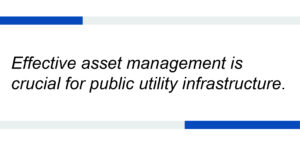Asset management is a critical strategy for public utility infrastructure, ensuring that assets are maintained, enhanced, and operated in the most cost-effective manner. By implementing a robust asset management plan, utilities can significantly reduce future capital expenses while maintaining high service levels.
 Step 1: Create an Inventory
Step 1: Create an Inventory
The first step in effective asset management is to create a comprehensive inventory of all assets. This inventory should include the age, condition, performance data, and maintenance history of each asset. With this information, utilities can prioritize maintenance and replacement activities based on the asset’s criticality and condition rather than on a less-efficient cyclical schedule.
Step 2: Take a Risk-Based Approach
Next, utilities should adopt a risk-based approach to asset management. This involves assessing the likelihood and impact of asset failure, which helps in allocating resources more effectively. By focusing on high-risk assets, utilities can prevent catastrophic failures that often result in hefty emergency spending and service disruptions.

Images courtesy of Esri
Step 3: Leverage the Benefits of Technology
Another key aspect is the integration of technology in asset management. Advanced tools such as Geographic Information Systems (GIS), Computerized Maintenance Management Systems (CMMS), and Asset Management Software (AMS) can provide real-time data and analytics, enabling utilities to make informed decisions about asset maintenance and capital planning.
Step 4: Commit to the Long-Term Investment
Lifecycle costing is also an essential component of asset management. It considers the total cost of owning and operating an asset over its entire life rather than just the initial acquisition cost. This approach helps utilities to understand the long-term implications of their investment decisions and choose solutions that offer the best value over time.
Step 5: Be Proactive with Maintenance
Moreover, public utilities should engage in proactive maintenance rather than reactive maintenance. Proactive maintenance can prevent the deterioration of assets and extend their useful life, thereby deferring the need for costly replacements. This approach also minimizes the likelihood of service interruptions, which can have significant economic and social impacts.
Step 6: Consider Sustainability
Sustainability should be woven into the asset management process. By considering environmental, social, and governance factors, utilities can ensure that their asset management practices contribute to the long-term health and well-being of the communities they serve.
Step 7: Focus on Continual Improvement
Finally, continuous improvement is vital. Asset management is not a one-time project but an ongoing process. Utilities should regularly review and update their asset management practices to incorporate new technologies, methodologies, and regulatory requirements.
Effective asset management is crucial for public utility infrastructure, encompassing a comprehensive approach that includes meticulous planning, risk evaluation, and the adoption of advanced technology. Lifecycle costing and proactive maintenance are integral to this process, ensuring sustainability and the continual enhancement of services. By adhering to these core principles, utilities can enhance asset performance, mitigate failure risks, and curtail long-term capital costs, thereby ensuring dependable service delivery to the community.
raSmith is Available to Assist
raSmith’s team of municipal engineering and GIS professionals stands ready to elevate your project with their expertise. Reach out to discover how raSmith can contribute to the success and longevity of your utility management projects.
